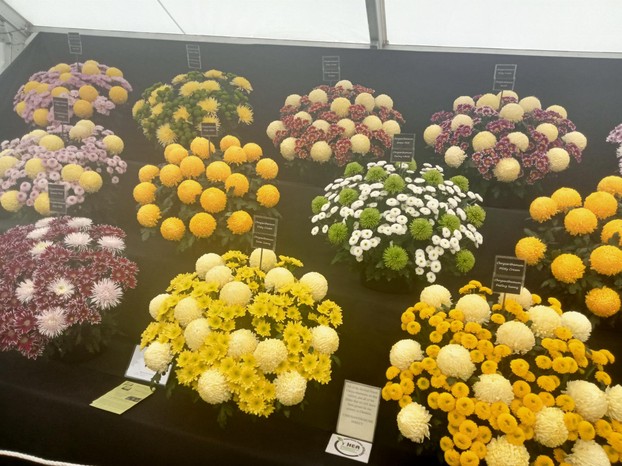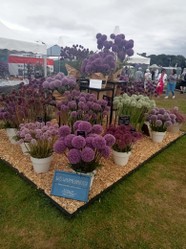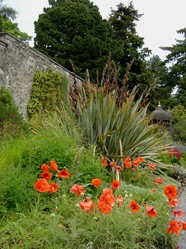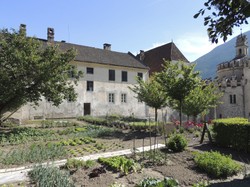Maureen knew the stall that she wanted to see, as she had seen it on the previous night's television. It was the stall of one of the two young designers who are every year selected to produce a show garden. The young man concerned was twenty six and split his time between wrestling and gardening. She had a friendly conversation with him, got a photo and moved on.
The gardens come in a variety of sizes. Some are large and detailed constructions with running water and edifices constructed on them. They cost thousands of pounds and are sponsored by companies or charities keen to promote their causes. The designers are highly paid professionals with a history of success. The terms of the design contract are that at the show's conclusion the garden will be dismantled and reconstructed on a site connected with the charity or one of the sponsor's choosing.
Some of the gardens are small, in tribute to the working class gardeners who made the most of their paved back yards in the industrial slums of British cities, the sort of place where I grew up for the first five years of my life. Some of these gardens are back to back, in memory of the worst kind of housing abolished in the nineteenth century. These residents needed allotments or window boxes. But there is another kind of urban gardening that is returning: the ginnel garden. Where I grew up we called ginnels entries, narrow back passages between terraced houses, but the word ginnel has become standard. A ginnel garden is a passage lined with containers for growing. These are made of durable materials.
We entered the ginnel garden at one end. There was ample room to walk between the containers. A large plastic cubic box nurtured a youhg apple tree, about a year old. Boxes, barrels and metal laundry tub filled with compost lined the walls. A second apple further on made a pair. Well tended flowers, some standing to six feet or more added beauty to the display, and vegetables, salads for example, grew in boxes. Potato planters were visible. A team of young women stood at entrance and exit, answering questions and giving out leaflets. I did not record the charity's name. It was, however an impressive exhibit.
Otherwise, the rest of the displays were found in the nursery stalls, which were showing the world what the nurseries had to offer. People were entering the stalls with trolleys provided by the show and exiting either directly to their cars, only to return for the rest of their load or depositing it for safe keeping in the marquee providing storage facilities. Some cars heavily loaded with plants went home that night.







 TheThousand Year Gardenon 11/26/2025
TheThousand Year Gardenon 11/26/2025
 Women of the Gospelson 10/11/2025
Women of the Gospelson 10/11/2025
 Religious Gardenson 08/25/2025
Religious Gardenson 08/25/2025
 Doctor of the Church: John Henry Newmanon 08/03/2025
Doctor of the Church: John Henry Newmanon 08/03/2025



Comments
Thanks
Excellent! Glad to hear it.
Yes, we had a great time, and it was made better by the fact that my physiotherapy is working so I managed to walk around the show ground, as opposed tomlast year, when I used a wheel chair.
Sounds like you had a wonderful time! I bet the views were absolutely wonderful.
Thankyou. I have a loyal and caring wife who has stood by me in my long illness.
There's something else that intrigues me even as I must mention what matters most essentially about the Tatton show 2024: you walked it with your wife!
Congratulations and Be Thou the Vision of Frank and Maureen and their family and of Veronica and her husband and their family!
Thank you for your comment below in answer to my previous observation and question.
Are cheese toasties snacks?
Can they be made as tastefully at home as through purchase?
If so, can they serve as part of a meal that suggests cold or hot or either-temperature drinks?
Very flavoursome. Texture was soft, but not so soft as to be runny.
The first paragraph to the third subheading, A little shopping, alerts us to tasty cheese toasties.
How do cheese toasties look, scent, taste and texture?
Thanks.